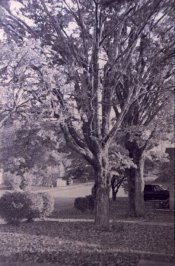Hello, this is my very first post, I hope everything will be ok !
I'm collecting old movie cameras, and I'm experimenting a way to cheaply test them all.
So I developed small portions of 16mm Fomapan R 100, here are the details :
(I am beginning with a 1938 Kodak Eight movie camera , exposing 1/30sec f8.)
all liquid temp is 16°C
- bleach with hydrogen peroxyde 12%, and citric acid 20g per liter, 20mn
- washing 5 mn, developing with HC110 B solution, 20mn
- fixing for 5mn, washing 5mn.
The result is a slightly yellowed negative, slightly under developed (or under exposed ?)
My problem is the "marble", or "crackles" that is appearing, I really don't know where it is coming from.
Maybe you can help ?
Thanks a lot !

I'm collecting old movie cameras, and I'm experimenting a way to cheaply test them all.
So I developed small portions of 16mm Fomapan R 100, here are the details :
(I am beginning with a 1938 Kodak Eight movie camera , exposing 1/30sec f8.)
all liquid temp is 16°C
- bleach with hydrogen peroxyde 12%, and citric acid 20g per liter, 20mn
- washing 5 mn, developing with HC110 B solution, 20mn
- fixing for 5mn, washing 5mn.
The result is a slightly yellowed negative, slightly under developed (or under exposed ?)
My problem is the "marble", or "crackles" that is appearing, I really don't know where it is coming from.
Maybe you can help ?
Thanks a lot !






